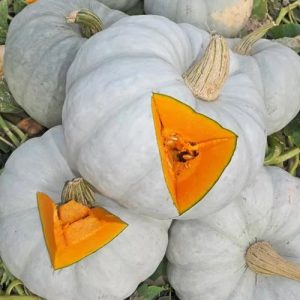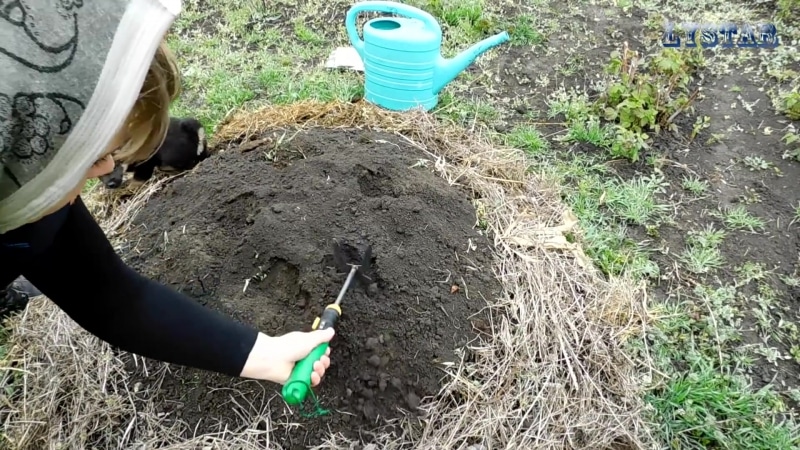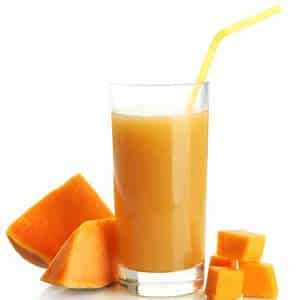Popular among farmers, “Winter Sweet” pumpkin has a pleasant taste and high yield for long-term storage.
Sweet winter pumpkin is one of the most productive and delicious varieties. Porridges, soups and juices, used for canning and pickling. The product is excellent for dietary nutrition and contains a complex of vitamins and minerals.
Let's take a closer look at how to grow the Winter Sweet pumpkin variety and how to harvest it correctly.
Description of the variety
Winter sweet is suitable for growing in the northern regions of the country. It has a high immunity to frost and drought, and can withstand heavy rains and fogs without consequences.
Distinctive features
The variety is a late-ripening variety; gardeners harvest the crop 120-130 days after planting. The bushes are spreading, the leaves are wide, dark green. Pumpkin is unpretentious in care; to increase immunity, summer residents arrange feeding and formation of bushes.
Fruit characteristics and yield
 The fruits are large, with a ribbed surface. The shape is round, flattened on both sides. Pumpkin weight varies from 5 to 11 kg.
The fruits are large, with a ribbed surface. The shape is round, flattened on both sides. Pumpkin weight varies from 5 to 11 kg.
The peel is gray, some vegetables have slight spotting. The pulp is dense, yellow. The taste is sweet and juicy, reminiscent of melon. Productivity is stable, from 1 sq. m, about 25 kg of ripe fruits are collected.
Interesting! Pumpkin is a low-calorie product; 100 g contains only 25 kcal. The vegetable is rich in fiber, protein and iron, contains vitamins A and B.Regular consumption of the product improves digestion, and a glass of pumpkin juice before bed is an excellent folk remedy for insomnia.
How to grow
For cultivation in the northern regions, the seedling method is used; in the south and in the middle zone, the crop is planted with seeds in open ground. Let's consider the basic rules of planting and care.
Planting by seeds

Large and heavy seeds are selected for planting. The sampling is carried out as follows: pour into a jar of water seeds and stir the liquid clockwise. Those that remain on the surface are not suitable for planting. The sunken seeds are taken out and dried.
Afterwards, the etching procedure is organized. Disinfect the seed with a solution of potassium permanganate or Bordeaux mixture. The seeds are placed in a fabric bag and immersed in the solution for 24 hours. Disinfection destroys pathogenic microflora on the surface of seeds and protects future plants from diseases and insect pests.
After disinfection, the seeds are germinated. To do this, they are wrapped in warm, damp gauze and put in a warm place for 3-6 days. To accelerate growth, add the stimulant “Kornevin” or “Heteroauxin”. Germination allows seeds to quickly adapt to external climatic conditions and show the best yield in the future. Sprouted seeds are placed in prepared beds, sprinkled with soil and watered generously with warm water.
Important! Pumpkin prefers loose and nutritious soil. It is better to choose a sunny, hilly area for planting. With the arrival of spring, the soil is dug up and fertilized with peat or vermicompost. Experienced gardeners recommend planting Winter Sweet after frost, in early or mid-May.
Planting seedlings
Cooking seedlings in late March. Plant pumpkins in wooden boxes, plastic cassettes, plastic pots. The main thing is that the container is dry and clean. To be safe, wash the container with running water and a solution of potassium permanganate.
As seedling soil, use a ready-made mixture from the store or soil from the garden. The advantage of the first option is that the soil is already disinfected in advance and saturated with nutrients. You can purchase it at any gardening store. Popular mixtures are “Universal” or “Strong” soil.
Pour soil into the container and make small grooves at a distance of 5-7 cm from each other. 2-3 disinfected seeds are placed in each hole and sprinkled with earth on top. The seedlings are watered with warm, clean water and placed on the sunniest windowsill in the house or near the radiator. If the windows face north, provide illumination with a phytolamp.
Water the seedlings as the soil dries out, approximately every 5 days. After 10 days, liquid organic fertilizing is organized. Bird droppings or manure are great for this. The next fertilizer is applied after another 10 days. Use potassium superphosphate or ammonium nitrate.
Important! After 2-3 weeks, the seedlings are planted on the site. The sprouts are watered with water first so that the soil is moist and does not crumble. The seedlings are carefully removed from the container with a lump of earth on the roots and placed on the garden bed. Gently pat around the stem and sprinkle with dry wood ash or sawdust.
Care
The basis of care is timely watering. Moisten the beds in the morning or evening to avoid sunburn. Water the bushes directly at the root; water should not get on the leaves, fruits and stems. Otherwise, the likelihood of fungi and infections increases.About 2 liters of water are consumed per plant, 2.5-3 liters on hot and dry days. Watering is stopped 2 weeks before harvest.

Pumpkin needs root and foliar feeding. The first option includes fertilizers with organic and mineral substances. Fertilizing strengthens the plant's immunity and improves the taste of the fruit. Peat, humus, and manure are used as organic matter.
Among mineral substances, preference is given to potassium and phosphorus fertilizers, as well as complex preparations - “Kimira”, “Zdraven”, “Magic Leika”.
Foliar feeding consists of spraying with nettle solution, Bordeaux mixture, and succinic acid solution. Their main goal is protection from diseases and pests.
Features of cultivation and possible difficulties
Pumpkin beds need regular loosening and weed removal. Carry out the procedure before watering. Weeding improves the quality of the soil, makes it more nutritious and light, and saturates it with oxygen. At the same time, they monitor the vines of the plant.
When 2-3 long shoots are formed, they begin to form a bush: the small side vines are removed, the top is pinched. Formation promotes healthy fruit development. If the remaining lashes are tangled together, they are straightened out and placed on the ground, sprinkled with earth in several places.
In addition to molding, it is important to monitor the amount of mineral supplements. An excess of nitrogen leads to curling and yellowing of the leaves, an excess of calcium leads to weakening of the roots. If you apply fertilizers incorrectly, there is a risk of disease. For accuracy, experienced gardeners mark the dates of fertilization on a calendar.
Important! When growing pumpkins in a greenhouse, the structure is ventilated daily.Greenhouses are characterized by heat and high humidity, which promotes the development of dangerous microbes.
Growing tips from experienced gardeners

Simple tips and recommendations from experienced gardeners will help not only protect pumpkin from negative factors, but also increase the shelf life of the product:
- If the soil is highly acidic, sprinkle the beds with lime and dry wood ash before planting.
- Before planting seedlings, the seeds are hardened by placing them in the freezer for 2-3 days.
- It is convenient to grow seedlings in peat tablets. They are made from environmentally friendly raw materials and are easy to use. Purchase tablets at a gardening store.
- After planting the pumpkin in open ground, each bush is covered with plastic wrap. It protects the sprouts from frost and rain. Remove the film after the first leaves appear.
- The optimal water temperature for irrigation is about +20 °C. It is not recommended to use tap water; it is better to water the vegetables with rain or well water, after warming it up in the sun.
- If the fruits are too large and heavy, place a wooden board under each. This prevents rot from occurring.
- When spraying with Bordeaux mixture or succinic acid, use gloves, a respirator and safety glasses.
Diseases and pests
Downy mildew, or, as people call it, downy mildew, occurs in pumpkin patches. The cause of infection lies in insect pests and weeds, high humidity and improper care. Downy mildew manifests itself in the form of yellow-brown spots on the leaves. As a preventive measure, spraying with ash is used, for treatment - “Planzir” or “Previkur”. If false dew is not detected in time, all the bushes will wither, and the fruits will lose their elasticity and taste.
Another common disease is root rot. It appears mainly at the flowering stage of the plant due to watering with cold water or an excess of mineral fertilizers. The roots become gray-brown in color, the leaves curl and dry out. For prevention purposes, the rules of crop rotation and watering regime are observed. Treatment is carried out with sprays based on zinc sulfate or with the drug “Fundazol”.
Among the pests, the melon aphid attacks the Winter Sweet. A small bug can destroy up to 80% of the entire crop. Aphids appear due to contaminated soil or improper sowing. The pest sucks nutrients from the bushes, causing the plants to slowly die. The product “Consento” or a solution of copper sulfate helps get rid of melon aphids.
In addition to aphids, slugs appear in the beds. The reason lies in non-compliance with crop rotation rules or contaminated soil. Get rid of slugs by spraying with iodine and milk.
Harvesting and application
 Winter sweet is harvested in September. The fruits acquire a characteristic gray color, the peel hardens. For long-term storage, vegetables are cut off with the stem removed. The collected pumpkins are wiped with a dry cloth and stored in a cool, dark place, such as a basement or pantry.
Winter sweet is harvested in September. The fruits acquire a characteristic gray color, the peel hardens. For long-term storage, vegetables are cut off with the stem removed. The collected pumpkins are wiped with a dry cloth and stored in a cool, dark place, such as a basement or pantry.
The harvest is used to prepare vegetable side dishes and salads, sweet dishes and desserts. Part of the harvest freeze And dried. Pumpkin harmoniously complements winter dishes, enriching the body with vitamins and dietary fiber.
Interesting! Pumpkin makes delicious cakes and pastries, pies and muffins. The product goes especially well with honey and cinnamon.
Advantages and disadvantages of the variety
The advantages of Winter Sweet include a juicy and sugary taste. The dense pulp is universal in use and suitable for dietary nutrition. Gardeners are pleased with the high yield and large fruits. Pumpkin is suitable for growing both in the south of the country and in the northern regions. Does not require special knowledge in care.
Among the disadvantages, the late ripening of the vegetable is noted. If the summer is rainy, the fruits do not have time to gain sugar content. In the middle zone and in the north, Winter Sweet is grown in seedlings.
Farmer reviews
Despite the presence of positive reviews about the variety, there are also sharply negative ones. What do gardeners say about Winter Sweet?
Maria, Moscow: “I like the Sweet Winter Pumpkin, it doesn’t cause any trouble in growing, the harvest always grows nicely. I use it fresh and make preparations for the winter.”
Alexey, Tyumen: “I planted Winter Sweet for the first time and was pleased. The maximum pumpkin weight is 12 kg, which made me happy. I recommend it for cultivation."
Natalya, Volgograd: “I planted seeds in open ground, apparently in vain. The sprouts developed root rot and had to be treated. Later, difficulties arose with the formation of the bush; there were a lot of lashes. The taste is, in my opinion, average.”
Conclusion
The high-yielding and late-ripening variety Winter Sweet is named so for good reason: the yellow, sweetish pulp tastes like a ripe melon. The variety is planted in sunny beds. In the northern regions it is grown through seedlings, in the southern regions - by seeds in open ground. Water the beds once every 5 days, fertilize every 10-15 days. Mineral fertilizers are alternated with organic matter to maintain balance.
Collected in early autumn, the fruits are picked along with the stalk. Pumpkin is used to prepare first and second courses, baked goods and desserts.